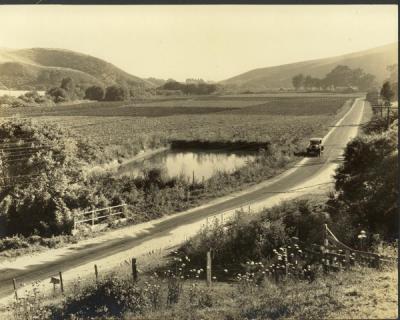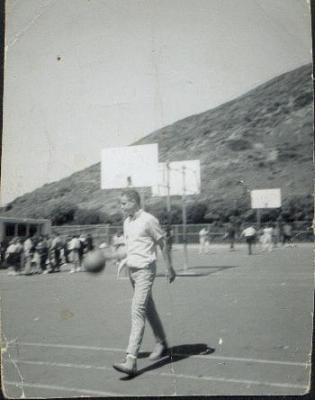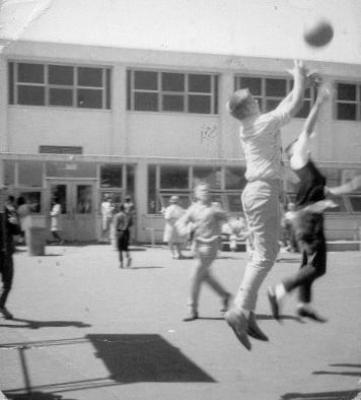Don’t you wish THiS was the road to Half Moon Bay? It is the old Highway 92.
 Photo: Spanishtown Historical Society, Johnston Street, Half Moon Bay
Photo: Spanishtown Historical Society, Johnston Street, Half Moon Bay

Created by June Morrall
In the 1890s Loren Coburn, the most hated man in Pescadero, built the Pebble Beach Hotel overlooking the popular and locally sentimental pebble-covered beach south of the tiny village. From what we know guests never stayed overnight– except for the watchman who was there to protect the new hotel from vandalism. (Among modern conveniences the Pebble Beach Hotel offered the luxury of hot and cold water). Business associates of Coburns (perhaps anxious to take advantage of the illiterate but wealthy man) sometimes held private parties at the hotel.
Local artist Galen Wolf wandered up and down the Coastside using his box of watercolors to preserve the past for us. Here, before it was torn down to make way for Highway 1, is Wolf’s picture of Loren Coburn’s Folly: the Pebble Beach Hotel at Pescadero where the rooms remained empty and, perhaps haunted, for decades.
In 1992 I published “The Coburn Mystery”, acknowledged as a definitive history of Pescadero. Regrettably, instead of the critics focussing on the history of Pescadero, they fell into the quagmire of environmental politics. The book covers all aspects of Pescadero’s fascinating history and should be read. “The Coburn Mystery” is still available and can be purchased at Ano Nuevo State Reserve.
I took these photos in the schoolyard at Herbert Hoover Junior High School in San Francisco in the early 1960s.
 Seattle Seahawks Head Coach Mike Holmgren dribbles the ball. (He was always the tallest kid in the school as well as school president). Mike and I were in the same class, graduating from Lincoln High in the mid-1960s.
Seattle Seahawks Head Coach Mike Holmgren dribbles the ball. (He was always the tallest kid in the school as well as school president). Mike and I were in the same class, graduating from Lincoln High in the mid-1960s.
Below: Former Superbowl coach (Green Bay Packers) Mike Holmgren shooting a jump shot: 
Special to Half Moon Bay Memories and El Granada Observer.
It was a hectic week for Gold.
The yellow metal was the lead story in the NY Times Business Section on Wednesday, November 19 and I was interviewed on the KGO 6 O’Clock News on Thursday.
The reason for all this hoopla?
The price of an ounce of gold went over $500 for the first time in over 20 years. (At the market close on Friday, Dec. 2, gold was trading at $504.50).
People are mystified by gold. They may revere ornaments produced by the Goldsmith (the gold wedding band is one of the most potent symbols in our culture), yet the notion of holding gold as an investment, or as part of one’s savings is clearly out of mainstream thinking.
It has been said that there are only 6 people in the world who understand Gold and that they have 7 different opinions. Well, let me try to “demystify” the subject, and, perhaps, persuade you to consider acquiring some beautiful gold coins.
First: Here are some of the “negatives” concerning gold ownership.
Gold doesn’t bring any return like a bond or stock. Also, storing gold could be dangerous and costly. The “crooks” love it and Safety Deposit Box fees at Banks are on the rise.
The “King” doesn’t like gold; he never has and never will. If you own a share of IBM stock, you are a patriot; own an ounce of gold and there is something wrong with you.
If someone wants to sell gold, it might prove difficult to find a buyer.
The government could confiscate gold as it was in 1933.
Some of the negative statements above are pure propaganda. Here are the immutable truths:
Gold and silver have been “money” in much of the world for almost 3000 years. By its nature, gold prevented the Kings and tyrants from increasing the supply of money whenever they wanted to. (As they do with paper).
It served as money in our own country from the beginning, the (1790s) through 1933 when it was demonetized. FDR’s first Executive Order in 1933 required Americans to bring their gold coins to the bank to exchange them for paper. They called it demonetization of gold, but it was outright theft.
Led by the US, the world has been off the god standard for about 75 years, yet every country retains gold as part of their national wealth.
Restrictions on Americans to hold gold ended in 1974.
If one has gold to sell, Iwould argue that there is nothing else they own that would be more liquid.
“Only Government can take commmodities as valuable as paper and ink and make them worthless.”
“When all the paper money is dust, gold will be of value.”
Yes, those quotes are pretty strong, but a prudent investor should own some gold.
Who knows, the next time KGO wants to interview me, it will be when gold exceeds $1000 per ounce.
Burt Blumert is a leading gold dealer (almost 50 years) in the San Francisco Bay Area. You can send him email at [email protected].
I took a ride on a boat on San Francisco Bay piloted by my longtime El Granada neighbor, Peter Logan,seen at the wheel, okay, partially seen at the wheel. Peter borrowed the yacht from a friend and we boarded it at the Marina, near Fort Mason. Behind Silvia we see the San Francisco skyline. At one point we got close to Alcatraz Island where a ferry boat had grounded and there was lots of excitement.
Gold price breaks $500 per ounce for the first time in 20 years– and this afternoon Ace-KGO-TV reporter David Louie interviewed Burt Blumert (my longtime companion) and gold expert at Camino Company, Burt’s Burlingame headquarters. Show airs during the 6 o’clock news on KGO-TV, an ABC affiliate in San Francisco.
Here’s some of my pix from the shoot:
At left: Burt Blumert (left) with veteran KGO-TV reporter David Louie
Center: KGO cameraman Mark adjusts equipment while Burt sits at the desk)
In the summer of 1946 the lifeless bodies of two little girls were found near a bed of wild lilies bordering the Havis Flower Nursery in Wagner Canyon in Montara.
Despite severe skull injuries, the childrenâs mother, 21-year-old Lorraine Newton, had survived the brutal attempt to murder herâand sought refuge overnight in an abandoned shack.
Next morning longtime Coastside resident John Kyne encountered the semi-conscious Lorraine, shoeless, wandering, and calling for Barbara Ann and Caroline Lee, the names of her children. It was Kyne who alerted authorities, and, Simmons, the constable from Half Moon Bay, arrived to take her to the nearby Community Hospital. (Community Hospital was run by Colonel Howard Roycroft, a military doctor, a reminder that the armed forces had had a presence on the Coastside during WWII.)
Constable Simmons noted that Lorraine was not wearing an engagement and wedding ring as most married women did in 1946. Had the murderer taken them?
At Community Hospital, Lorraine slipped in and out of consciousness, calling for her children and husband Vorhes. Colonel Roycroft wouldnât let police question her. The head injury was severe and her survival was uncertain. More importantly after examining his patient, Dr. Roycroft had important information for police. Lorraine was pregnant. Lorraine Newton asked for her children and her husband Vorhes.
When she began to recover, police were permitted to ask a few questions. The only thing Lorraine recalled, she told them, was sitting in a car with her husband and daughters and watching the waves at Rockaway Beach in Pacifica. Everything else remained a blank.
Meanwhile a statewide search for Lorraineâs husband, Vorhes, was underway. The 24-year-old glazier had vanished and police were anxious to interrogate the man who had become a murder suspect in what the press dubbed âThe Babes in the Woodsâ? case.
Cops knew Vorhes had returned the car he borrowed from his sister, the car that he drove to the Coastside. A search of the vehicle produced a shovel, a possible murder weapon. They tracked Newtonâs movements back to the coupleâs apartment in Alameda. On the bed Newton had spread out one of his wifeâs dresses and beside it, a baby bottle.
As Lorraine Newton recovered, police were permitted to ask her questionsâbut Dr. Roycroft wouldnât let them tell her about the death of her daughters. Asked about her husbandâs character, she said he was the most lovable man on earth. About the events which lead up to her injuries, she recalled little. All she could remember was sitting in a car with her husband and daughters, watching the waves at Rockaway Beach in Pacifica. Nothing else.
And that was what the newspapers reported.
Police fanned out to question Lorraine and Vorhesâ neighbors and friends in Alameda where the couple lived. The first reports offered nothing out of the ordinary, a picture of a happily married coupleâbut cracks in this picture emerged as a close friend said Lorraine hated her husband, adding that she wouldnât be with him if it werenât for the children.
The murder story was headlined in so many papers that San Mateo County police figured it wouldnât be long before Vorhes Newton would be caught. His picture was posted everywhee. Cops were playing the waiting game.
And it was a short wait– a couple of days after the horrific crime, Auburn officials notified San Mateo County Deputy Sheriff Walter Moore that they had his man in custody.
How did they catch him?
Part of the answer came from Vorhes, part of it from several other witnesses.
A motorist offered Vorhes Newton a ride when he saw him, soaked and disheveled, wandering along the highway near Emerald Bay at Lake Tahoe. Vorhes told the driver his clothes were soaking wet because he had slipped and fallen into the cold lake water. He had a black eye and visible abrasions so the driver took him to a tavern where a doctor gave Newton first aid. The doctor recognized Vorhes from the newspapers and alerted the Tahoe constable who took him into custody, driving him to the bigger jail at Auburn.
Elated with the news, Deputy Sheriff Walter Moore raced to Auburn to pick up His prisoner. Under questioning, Vorhes Newton repeated the same thing as his wife. He recalled watching the surf at Rockaway Beach, then, he said âeverything went blank.â? Afterwards he remembered waking up on a park bench in Reno [he had taken the bus or train there] and it was there that he read about the murders in a newspaper.
âI woke up in Reno, with a paper lying over my face,â? Newton told Sheriff Moore. âI decided that I had better go back. I took a bus and hitch-hiked as far as a resort on the California side of Lake Tahoe, Eagle Falls, by Emerald Bay. I clambered up the rocks and fell into the lake, then climbed back to the road.â? He complained of severe back pain, had one black eye and abrasions all over his body.
Sheriff Moore branded Newtonâs story a fake. âHeâs covering up and telling a lie,â? Moore said. He told reporters Vorhes read his wifeâs account in the newspapers. Heâs just repeating her story. What he didnâtâ tell reporters was that he found Lorraineâs engagement and wedding ring in Vorhesâ possession.
Newton was driven back to the county jail in Redwood City. The sky was carbon black as three hours of heavy grilling began– but failed to break his story. When confronted repeatedly with the facts, Vorhes, by now weary and haggard, insisted âhe blanked outâ?. âIâm not a brute,â? he swore, âI couldnât have done it. I couldnât have done it.â? The same thing, over and over.
Making little headway, Sheriff Moore quit for the night. âWhat do I charge him with, â Night Jailor Paul Jenson asked Sheriff Moore. âOh, hell, charge him with murder,â? Moore snapped.
The âBabes in the Woodsâ? case was attracting national attention, becoming a big case. It was time for Walter Mooreâs boss, Sheriff James McGrath to step into the picture and McGrath announced he was now taking the lead in the investigation.
âI think he [Newton] should be made to see his daughtersâ?, Sheriff McGrath told a clutch of reporters. The little girls were lying in the William Crosby Mortuary in Burlingame.
Newton hadnât hired a lawyer yet but money wasnât a restriction as his father, Benjamin, was a prominent rancher near Lodi. At first the family hired Alden Ames, a former superior judge. Ames said his client was being put through the third degree and anything he said would be questioned in court as having been obtained under duress.
Alden Ames soon retired from the case and was replaced by the aggressive defense attorney Leo Friedman known for winning some tough cases.
Up to this point Deputy D.A. Fred Wycoff was handling the prosecutionâs case. He told reporters he had enough evidence to convict and that it would be a quick trial.
Where Newton would be arraigned on two counts of murder was still up in the air. The plan was to take him to the court of Manuel J. Bettencourt in Half Moon Bay. But Vorhes complained of injuries sustained in the fall at Lake Tahoe and the doctor who examined him said he didnât know if the prisoner âcould standâ? the physical pain of the ride from Redwood City to the Coastside.
He might not be able to make the bumpy ride to Half Moon Bay but there was no excuse why Vorhes Newton could not be taken to the Crosby Mortuary in Burlingame to see the bodies of his baby daughters. Face up to what he had downâand once there, he almost immediately cracked and confessed that he had beaten them to death after first attempting to kill his wife.
In the presence of six officials, with reporters banned, Newton confessed that he struck his wife and babies first with a baby bottle, then a shovel at the spot where they were found, a lonely ranch road in Wagner Canyon near Montara.
And the reason for the brutal crime was finally was revealed: The couple had quarreled over an abortion.
Sobbing, Vorhes said he struck his wife first but didnât know why he took it out on the kids.
After the confession a decision was made: The arraignment on a double murder charge would take place in Half Moon Bay at the Court of Justice Manuel J. Bettencourt.
â¦.To be continued